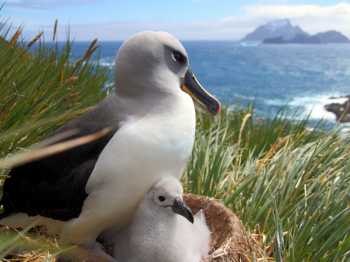
A Grey-headed Albatross guards its chick on Bird Island in the South Atlantic, photograph by Stephanie Prince
William Mills (British Antarctic Survey, Cambridge, UK) and colleagues have published open access in the Proceedings of the Royal Society B Biological Sciences on mercury levels in Grey-headed Albatrosses Thalassarche chrysostoma.
The paper’s abstract follows:
“Mercury (Hg) is an environmental contaminant which, at high concentrations, can negatively influence avian physiology and demography. Albatrosses (Diomedeidae) have higher Hg burdens than all other avian families. Here, we measure total Hg (THg) concentrations of body feathers from adult grey-headed albatrosses (Thalassarche chrysostoma) at South Georgia. Specifically, we (i) analyse temporal trends at South Georgia (1989–2013) and make comparisons with other breeding populations; (ii) identify factors driving variation in THg concentrations and (iii) examine relationships with breeding success. Mean ± s.d. feather THg concentrations were 13.0 ± 8.0 µg g−1 dw, which represents a threefold increase over the past 25 years at South Georgia and is the highest recorded in the Thalassarche genus. Foraging habitat, inferred from stable isotope ratios of carbon (δ13C), significantly influenced THg concentrations—feathers moulted in Antarctic waters had far lower THg concentrations than those moulted in subantarctic or subtropical waters. THg concentrations also increased with trophic level (δ15N), reflecting the biomagnification process. There was limited support for the influence of sex, age and previous breeding outcome on feather THg concentrations. However, in males, Hg exposure was correlated with breeding outcome—failed birds had significantly higher feather THg concentrations than successful birds. These results provide key insights into the drivers and consequences of Hg exposure in this globally important albatross population.”
With thanks to Richard Phillips.
Reference:
Mills, W.F., Bustamante, P., McGill, R.A.R., Anderson, O.R.J., Bearhop, S., Cherel, Y., Votier, S.C. & Phillips, R.A. 2020. Mercury exposure in an endangered seabird: long-term changes and relationships with trophic ecology and breeding success. Proceedings of the Royal Society B Biological Sciences doi.org/10.1098/rspb.2020.2683.
John Cooper, ACAP Information Officer, 06 January 2021

 English
English  Français
Français  Español
Español